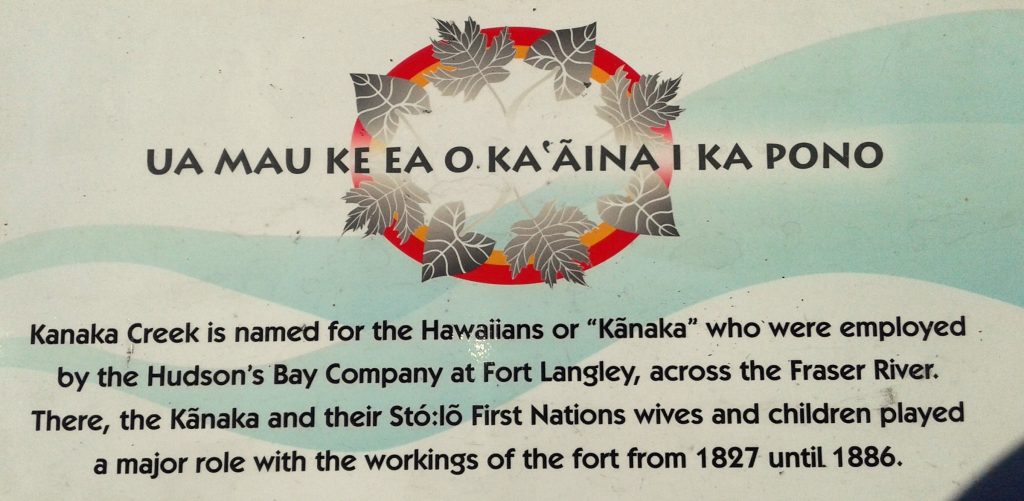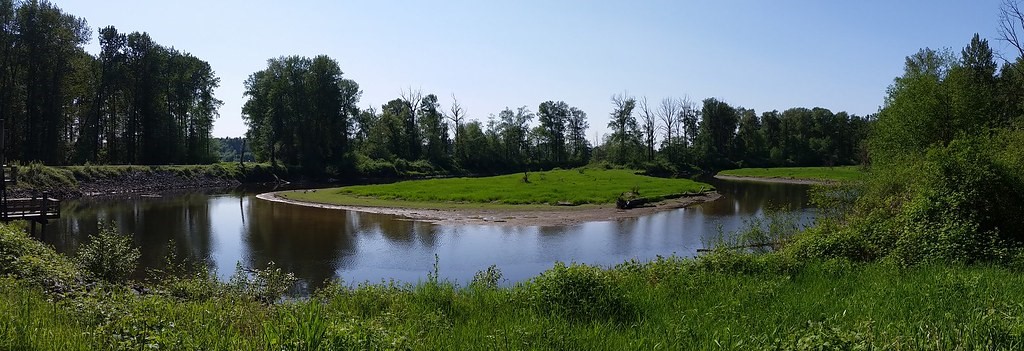By Gunter Rebele

Maple Ridge will commemorate the 150th anniversary of its incorporation in February 2024. The incorporation took place 14 years after the pre-emption legislation was passed in 1860.
Recently I went through the history of Maple Ridge again and found repeatedly the statement that Samuel Robertson was the “first settler”, or in others the “first European settler”, in Maple Ridge.
Is that a historical fact or a myth?
That statement struck me as being rather Eurocentric, so I wanted to look at the settlers’ history from a different perspective. As a result of this research, I would like to suggest the Hawaiian Maillot PeoPeoh as the first non-native settler in Maple Ridge. The historical documents mentioned eleven European families, but no Hawaiian or Indigenous names were included.
My interest in the Hawaiian community and PeoPeoh was sparked during my research with the Maple Ridge Family History Group for the “On the River” project. In this process, I collected lots of material about the Hawaiians at the Hudson Bay Company (HBC) and the Hawaiian community in Maple Ridge.
Peopeoh was not the settler with the most acreage, laborers and money, but one, who, despite his race and lower status, played an influential part in the local history, and was a leading and inspiring force in his community.
PeoPeoh’s early years in Fort Langley
The most prominent Hawaiian coming from Fort Langley was Maillot PeoPeoh. He was one of the first Hawaiians recruited by the HBC. He joined the company in 1817 when he was 19, and in 1827, he came with the original crew from Fort Vancouver, WA, to build Fort Langley.
The HBC’s history of Fort Langley, closely intertwines with that of the Hawaiian people. One cannot write about one without mentioning the other. The HBC recruited the Hawaiians for shipping, trapping, hauling heavy pelts, preserving salmon, farm labor and ‘general drudgery’.
“PeoPeoh was a relative of the Kamehamas Kings of the Sandwich Islands (now Hawaii). He “acted as a guardian of the Hawaiians who were employed by the HBC, and he was a central figure in the Hawaiian settlement on Kanaka Creek in British Columbia.”[1]
“Maillot PeoPeoh, upon leaving his home island, promised his grandfather to name something in the new country in honor of his people. A creek situated across the river from the fort, in the area at what is now known as Albion, and was named Kanaka Creek because of this promise.”[2]
Chief Trader, James Yale, made it a part of his policy to get his men married to Indigenous women, securing daughters of chiefs, usually called “Princesses”, for the white men. The offspring of many of these marriages still live near Fort Langley and Maple Ridge. [3]
PeoPeoh married Katherine, the daughter of one of the Kwantlen Sub Chief’s daughters, and they had seven children. Despite the long hours he had to work for the HBC, he was able to eke out a life for himself. He cleared and cultivated a piece of land close to Fort Langley and another piece close to the mouth of Kanaka Creek. In 1858, when the colonial government declared Derby a township and began to subdivide lots, the ‘squatters’ were ordered from their home on the former HBC lands. PeoPeoh, who had already cleared and cultivated, and been in occupation of a piece of land near the old Fort Langley location sent a petition to Governor James Douglas, for compensation and for permission to pre-empt land on the north side of the Fraser River, next to the confluence of the Kanaka Creek. He wanted forty-seven acres as reparation and wanted it now so that he could plant the year’s crops. The governor granted that request and PeoPeoh staked his claim of 47 acres there.
According to the Maple Ridge Community Archives, “There are a few sources out there claiming that Peopeoh came to the Albion area between 1831 and 1839.” At that time, there were no property rights or titles, so the employees of the HBC just occupied some land.
It is worth noting that Sam Robertson arrived at Fort Langley in 1843. Thus, PeoPeoh was the first to settle in what is now Maple Ridge.
The Hawaiian community
Indigenous Hawaiians in Canada have been living in the Vancouver and Victoria areas since the 1780s, when some of the crew of transpacific ships jumped ship to work in the growing fur, mining and timber industries. “Kanaka” is a Hawaiian term meaning “laborers or young men”. “The earliest settlers in Maple Ridge were Hawaiians called Kanakas that were employed by the HBC.” [4]
In about 1850, continual desertions by men heading off to the Fraser River and Cariboo Gold rushes left the HBC almost entirely dependent upon Kanakas and local First Nations to sail ships and cultivate farmland. After the HBC lost its trading monopoly in 1858, many Kanakas working at Fort Langley moved to Kanaka Creek and settled there, often with local Indigenous (usually Kwantlen) wives.
After leaving the HBC in 1857, Peopeo and Katherine, along with “a number of Kanakas, moved to the north side of the Fraser, opposite the original fort site near Berry Creek, which was later renamed Kanaka Creek.” [5]
The Hawaiian community was the oldest non-Indigenous community of the district’s settlements, and was only slightly younger than Fort Langley itself, adjacent across the Fraser River, at the former settlement of ‘Derby’. [6] Articles and newspaper snippets often use the term ‘Hawaiians on Kanaka Creek,’ but they always mention it in very general terms.
The pre-emption legislation was passed in 1860, but it seems that Sam Robertson and Peopeoh received their lots earlier, approximately in 1858, and could eventually legalize it when pre-emption was possible.
Some of the Kanakas went with Samuel Robertson, living and working on his farm. Others chose to pre-empt land themselves and receive grants on the north side of the Fraser River, opposite the settlement of Derby; still others chose to move with their families to the nearby Whonnock Reserve.
After 1860, the Hawaiians resided across the river from Fort Langley, in an area known as ‘Kanaka Creek’, which eventually became a historical rural residential region situated within the Municipality of Maple Ridge. It is located along the banks of the Kanaka Creek, between Haney and Albion.
The known names of the earliest settlers on Kanaka Creek were PeoPeoh, (Maillot Pio Pioh), Joseph Mayo (Maher), Aglae (Paiwa) PeoPeoh, Robert Vivicare (Wavicareea, Verkerin), Chier, Nahu and Apnaut (Apponette). [7]

Maillot PeoPeoh died in 1860/or 1862, at the age of 62 or 64, in Maple Ridge and was buried at the Hudson Bay Company Pioneer Cemetery in Fort Langley. He still lived long in the memories of the Hawaiians in Kanaka Creek, as he was related to all of them in one way or another.
This community lasted for about 30 to 40 years before they had to move again. When the Canadian Pacific Railway was built, it ran its tracks right along the Fraser River, obliterating the little riverside community. The last house was gone by 1912. [8]
From the Maple Ridge Community Archives, I received most of the pre-emption records in the Albion area. However, the landholder map included only the biggest landholders. Since the Hawaiians mostly held smaller lots, they were not mentioned in the landholder map; they lived mainly on subsistence farming and fishing.
Hawaiians in Maple Ridge ,1881
After going through all the collected data, I realized that the community had to be quite small, as all of the Hawaiians in Maple Ridge came from the disbanded HBC in 1858. At that time, there were only fifteen employees, with or without families.
Looking through nearly 2000 names in the 1881 Maple Ridge census, I found that 20 years after the first Hawaiian settlers moved to Kanaka Creek, only three families and two individuals remained, totaling 19 people of Hawaiian descent. In contrast, there were several hundred Chinese Canadian inhabitants. By 1881, the majority of ex-HBC employees had either moved to Vancouver or Washington State, become members of the Whonnock Reserve, or passed away.
When I finished my research, I came to the following conclusion:
1. The first settlers in Maple Ridge around the Kanaka Creek area were the First Nation Kwantlen People. In 1827 or shortly after, they came from downriver from present-day New Westminster and established a village at the mouth of Kanaka Creek for ready access to trading opportunities with Fort Langley,[9] and to escape the threat of raids from the Yuculta tribe. [10]
2. Peopeoh was the second to settle this area. He was reported to have cleared and cultivated a piece of land near the mouth of Kanaka Creek between 1931 and 1939. He was, therefore, the first non-Indigenous settler in Maple Ridge.
3. Samuel Robertson pre-empted his land in 1860. He was not the first to pre-empt land in Maple Ridge, but the 78th who registered. He probably pre-empted land that he planted already a few years before, as did Peopeoh. [11] Therefore, he can still be considered the first European Settler, but came after Peopeoh and the Kwantlen people, who were the very first settlers in Maple Ridge.
[1] Jason O. Allard, “Reminiscences,” Howay Collection, UBC Rare Books and Special Collections
[2] https://keeps.org/kanaka-history/
[3] https://open.library.ubc.ca/cIRcle/collections/ubctheses/831/items/1.0105443
[4] https://www.wilcoxrealestate.com/neighbourhoods/173/maple-ridge-british-columbia
[5] Jason O. Allard, “Reminiscences,” Howay Collection, UBC Rare Books and Special Collections
[6] https://dbpedia.org/page/Albion,_British_Columbia
[7] https://core.ac.uk/download/pdf/5014697.pdf
[8] https://explorasian.org/learn/education
[9] http://www.metrovancouver.org/services/parks/ParksPublications/KanakaManagementPlan.pdf
[10] https://keeps.org/kanaka-history
[11] https://search-bcarchives.royalbcmuseum.bc.ca/uploads/r/null/d/a/1/da1c3c43bcd2994f85c54d9774fd329a7cb65d9ee04b0b326fb1084a501a8931/G R_1069_1_15_91.pdf